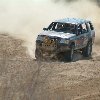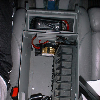@koda2000 @CDW6212R
Good time to pick my brain, before it gets any older! I cut my teeth setting up 9-inchers long ago.
Pinion Depth is a dimension number imprinted on the Pinion Gear used in determining initially how much shimming the Pinion needs to locate it in the housing fairly close if not exactly, to where it must be to accomplish proper gear tooth mating pattern. Thrown in with this is the fact that the Pinion has shims to also preload it's 2 bearings. Pinion Depth has nothing to do with gear tooth clearance, known as "backlash", or "lash", though the depth affects lash.
Backlash is clearance between the teeth of the pinion and the ring gear, usually slightly more than 0.010" measured at the outer periphery of the ring gear, at a right angle (tangent) to it's rotation. Lash is accomplished either through the use of shims behind the differential carrier bearings, the cone & roller assy, or use of threaded "nuts", which are round and cup-shaped and have perforated holes in them to allow turning them.
The threaded adjusting nuts:
Measuring backlash:
'Course, you guys will be stuck with the shimming method; few axle designs used nuts. This means that without the sophisticated measuring tools shown in the Ford Shop Manuals, you cannot predict exactly how much shim "stack" you will need, for either pinion bearing preload, depth, or lash. Depth and lash both affect tooth contact pattern, and while lash may be right-on, the pattern may be so far off, the gears will sing like hell!
A comparison of tooth contact pattern. Done by lightly "painting" teeth with Prussian Blue grease, and rotating the ring gear by hand while holding a rag tightly around the pinion yoke, to "load" the teeth:
The real reason for all this shim monkey-business lies in the tolerances present due to manufacturing practices. Every part in use has some tolerance associated with it, thus when a ring and pinion must mesh accurately within a few thousandths of an inch, set-up must work around tolerances. Want more pics, just ask! imp










